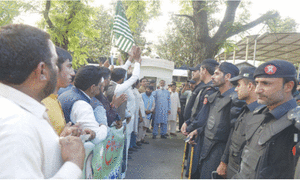UNTIL the divide-and-rule policy was enforced by the colonial power after the mid-19th century, Hindus and Muslims lived in harmony in South Asia. They still do in South India where bigotry in both the communities has not raised its ugly head, as has been the case with the rest of South Asia. In the northern and central parts of the subcontinent, those with political and economic self-interests have tried, quite often successfully, to create a gulf between the followers of the two religions — Islam and Hinduism.
A misunderstanding that prevails is that Muslims ruled India for the most part of the seven centuries, until 1857. The fact is that those rulers just happened to be Muslims, just as the Rajput rulers were Hindus and Maharaja Ranjit Singh was a Sikh. The Muslim kings were not there to spread Islam. It was the Sufis who won the hearts of members of other communities by their humanistic preaching and practice. A large number of their followers adopted Islam as their religion but many of those who didn’t continued to revere them, as can be seen by a large number of non-Muslims flocking to their durgahs.
The commonalities in the culture of these two major communities of the subcontinent has been termed Ganga-Jamuni. It refers to the confluence of two major rivers. Thus when accomplished artist and noted writer Naz Ikramullah decided to author a book on the subject she couldn’t think of a more appropriate title than Ganga Jamuni, Silver and Gold: A Forgotten Culture.
How much the Hindus and the Muslims have in common can be judged by just one example: when a bride leaves her parents’ house, she is blessed with the same prayer: “Sada suhagan raho” (may you never become a widow).
The news of the birth of a male child in many families among not just the Hindus and the Muslims, but members of other religious communities as well, is greeted with happiness, which is quite obvious because the families would receive dowries brought by their daughters-in-law rather than slog to save for their daughters.
Hospitality is also a common trait among the Hindus and the Muslims. What is heartening is that the practice of not letting anyone but high-caste Hindus enter their kitchen or eat in their plates is no longer very common today. In all my visits to India I have been invited to lunches and dinners by even the Brahmins. That the practice of ‘untoucability’ is on the wane has been confirmed by Muslim friends and relatives in India.
When the Ottawa-based Ikramullah flies back every year to what she calls her roots during the harsh Canadian winters, she makes her parental home in Karachi her base town but doesn’t miss a chance to visit India, and quite often Bangladesh.
You turn the first page of the book and you are greeted by the reproduction of a lovely calligraphed page of the Persian translation of the Ramayana, which is headlined by the Islamic verse, “Bismillah hirrahman nirahim”. The original occupies a place of pride in the Raza Library in Rampur, UP.
In the introduction, Ikramullah, who has the advantage of being the daughter of a well-known cultural figure of the last century, Begum Shaista Ikramullah, drifts down memory lane to show how her Westernised education but Ganga-Jamuni moorings helped her in appreciating music, fine arts and the traditional embroidery and designs on clothes.
However, in the first chapter, ‘Historical Background,’ she falters twice. Once, when she mentions that the earliest Muslims (read Arabs) to come to India were traders who came to Surat in the 7th century. The fact is that the first Muslim traders voyaged from Arabia to the Malabar coast. It was in the 8th century that they landed in Surat.
The second error occurs when Ikramullah writes: “During Emperor Akbar’s reign the fusion of Indian and miniature painting commenced; this was consolidated in the reign of Emperor Humayun.” The question is, how can any trend that commenced during the reign of the third Mughal Emperor be consolidated during the rule of his predecessor?
Moreover, the statement that there are more Muslims in India than in Pakistan or Bangladesh is statistically wrong because Pakistan is second only to Indonesia in this context. Which comes third, India or Bangladesh, is for the author to conclude after consulting statistical figures.
Ikramullah writes knowledgeably about the common grounds between the Sufi and Bhakti movements. She refers to Bauls, the Bengali minstrels, and added to my knowledge that there are Muslim Bauls also.
The chapter on fine arts and the performing arts also makes informative reading, so does the one about what the author calls “cultural fusion.” A lot of information about the wedding ceremonies and bridal adornment, shared by the two communities, is given, not to speak about various other aspects of the common lifestyle.
Accompanying the book is a DVD. The first part is the audio-visual depiction of what has been discussed in the book, while the second is devoted to Muslim women of Pakistan, India and Bangladesh. It seems out of context because it makes no mention of Hindu women. Hence the section cannot be considered a part of Ganga-Jamuni culture.
In her revised edition one hopes that Ikramullah will remove the errors that somewhat mar what is a sincere effort.
Ganga Jamuni, Silver and Gold: A Forgotten Culture
(HISTORY)
By Naz Ikramullah
Bayeux Arts Inc, Toronto and Bengal Publications, Dhaka
ISBN 978-1-897411-74-2
66pp.














































